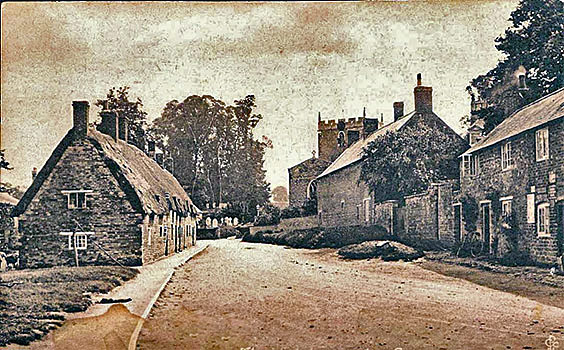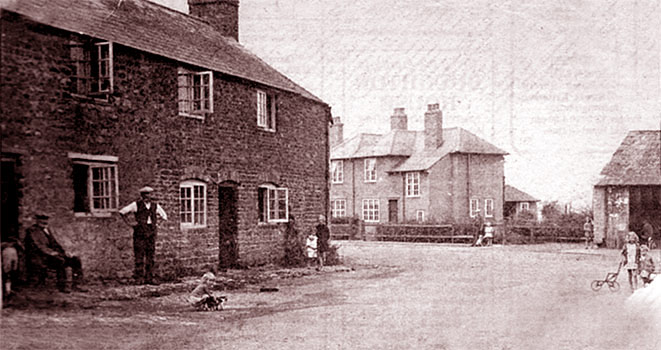John Meads 2015 - from The Northampton Mercury & Herald 18 December 1931 |
||||
|
||||
|
||||
|
OUR CHANGING COUNTRYSIDE - BARTON SEAGRAVE - A GREAT STRUGGLE FOR POSSESSION A few years ago, Burton Latimer and Barton Seagrave were clearly seperate places. Today, where does none begin and the other end? The casual observer, travelling by road from say Bedford to Market Harborough will find it impossible to say whether he has passed Burton Latimer, Barton Seagrave, or Kettering individually. Rather would he be inclined to say: "I went through Burton Latimer which appeared to be rather a small parish at first and then three miles ahead it blossomed forth into a large town," that large town being of course, Kettering. If you asked our traveller if he had not observed Barton Seagrave he would at once reply that he could not truthfully say he had. Kettering and Burton Latimer are fighting for Barton. Both Urban Councils are casting a keen eye on to its boundaries. Kettering has nothing to fear from its covetousness. But if Burton Latimer is not very careful it will find itself in the unenviable position of a fish that has swallowed a smaller fish and suddenly finds itself in the interior of a whale. In other words, while Burton Latimer is angling for extension on its Northern boundaries, Kettering would not hesitate to take into its net both Burton Latimer and its newly acquired Barton Seagrave. A Flirt Perhaps the fault lies mainly with Barton Seagrave itself. Like a belle with two strings to her bow, she has extended advances to the towns on both sides of her. So far as Burton Latimer is concerned she has not only sent out overtures of friendship as it were to that town by means of a line of bungalows along the side of the main road, but she has also made doubly sure of linking hands with the town by way of rows of domiciles along Polwell-lane. Barton Seagrave should to all intents and purposes belong to Burton Latimer from a practical point of view. The town has been supplying several of the new houses with water for some time, and in some cases those houses perhaps would not have been built had it not been for the lure of water. To those of us who are romantic or old fashioned, if you prefer that description, the gradual absorption of Barton Seagrave is not pleasing. A few years ago there was not a more beautiful rural retreat in the county. It was the construction of the admirable Wicksteed Park which paved the way for Barton Seagrave's lapse. Before the advent of the Park the village was best known as an excuse for a charming Sunday evening's walk from Kettering. Who from the large town at some time or another has not attended the simple services at the unique little church dedicated to the somewhat obscure Saint Botolph, a picturesque building with its famous typanum over the North door enriched by a mask of a human face between figures of monsters, creations of our Norman ancestors? The Lost Barton Barton Seagrave at one time appeared to have been made up entirely with its Church, Rectory and Manor House, with a few cottages thrown in by way of an afterthought - at least that is the impression. The three outstanding buildings are huddled together in a manner which suggests that space was a matter of great consideration in those days. The Hall seems to have been built at a distance from the crowded little parish which rather indicates that the owner could not make up his mind whether he wanted to be in Barton Seagrave or out of it. A Castle, too, apparently existed at some time or other, judging by mounds and dykes and moat-like excavations, which are clearly traceable in a field close by. But we have not set out in this article to delve into the history of parishes referred to. Rather would we deal with recent changes which have come about and changes which are imminent. By entering the heart of Barton Seagrave, which is by no means difficult to find, the visitor sees there has been very little attempt to destroy its rural charm. A few Council houses have appeared and mix strangely with the old-world cottages, and, most amazingly of all, Barton Seagrave has a modern shop in course of construction! If you enter the village from the Kettering end there is nothing to indicate that Barton Seagrave has undergone the slightest metamorphosis. But approach it from Polwell-lane and, with nothing but Council houses to meet the eye, you are under the impression you have come across a modern town, an illusion which is quickly dispelled upon proceeding a few steps further. A Death Trap Barton Seagrave was best known, years few ago, for its steep hill, and a death trap corner near its foot. But that reputation has gone, for, with his usual generosity, the late alderman Chas. Wicksteed, soon after he has purchsed the Hall (now a Guest House), sacrificed a portion of the front garden in order that the sharp bend in the main road could be rounded off. This is regarded as one of the most important road improvements the county has known in recent years. Quite recently Barton Seagrave erected a large wooden Parish Hall to meet the growing social needs of not so much its own people as of newcomers represented by the ever-increasing numbers of tenants and owners of bungalows and villas which are springing up in all directions around the village. Whilst this Hall considerably detracts from the beauty of the immediate surroundings of the Church, not forgetting the delightful avenue of trees and country walk leading to Burton Latimer-road, the parishioners evidently hold the conviction that the utilitarian aspect must override that of the picturesque. Not an unnatural sentiment when it is remembered that Barton Seagrave lost its individuality when its isolation disappeared. Perhaps the villagers finally succumbed to the irresistable march of progress when the motor-car first displaced the horse. What was a typical village smithy in the very heart of Barton Seagrave is now a shelter for someone's car. " O tepora! O mores!" But what of Burton Latimer, the town seeking to embrace Barton Seagrave in its fastness? Is the town's claim for more extensive frontiers justified? Yes, we think it is, although the parish has not quite emerged from that stage where it decided to drop the description "village," call itself a town, and endeavour to live up to that dignity. We should like to see long, rambling walls running along main thoroughfares give place to shops and thus give the place a more business-like appearence. That Burton Latimer has changed during the last few years is due to the old Parish Council giving place to an urban authority, after a terrific fight. Progressive ideas, long bottled up, come out, housing schemes were embarked upon of a comparitively large scale, and road-making, sewering, paving, and the like were matters which followed in their train. Old Burton Latimer is left practically untouched as regards to its structure; rather is the Council turning its attention to outlying fields and waste land for the development of housing, and fine estates have sprung up. And now that the town has secured urban status, it intends grimly sticking to it. Burton Latimer does not readily give up that which it has won. |
||||

